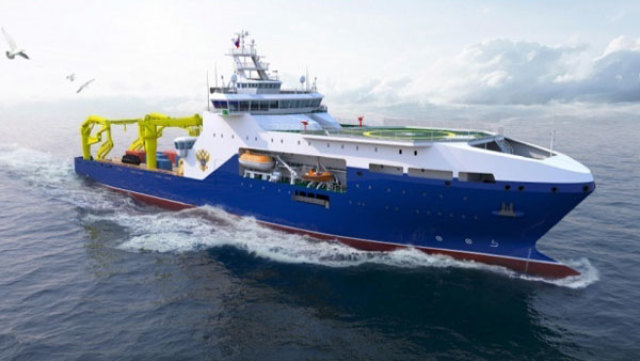One of the most important events of 2020 was the beginning of the revival of the Russian research fleet. For the first time in many years, money has been allocated for the creation of new research vessels (NIS). What characteristics will the new scientific ships of Russia have and why their early creation is of such great importance for the country?
At the moment, the research fleet of the Ministry of Education and Science has 13 vessels with a total displacement of more than 40 thousand tons. Not only is this number absolutely insufficient, but the ships themselves have almost exhausted their resource.
Three years ago, in October 2017, the Ministry of Defense published a report on the state of national security of the Russian Federation in the field of maritime activities. As the document explicitly stated, the fleet of the Federal Agency for Scientific Organizations( FANO), Roshydromet and Rosnedra came to a "catastrophic and crisis state".
Overripe problem
At that time, the average wear of the remaining Russian research vessels (NIS) exceeded 80%, and the age was 34 years. Now, of course, the situation is even more deplorable.
The most difficult situation was with Roshydromet, which, since 2013, due to the lack of budget funds, had to take its vessels out of service every year-because of their extreme wear and tear. Meanwhile, in 2016 alone, the agency conducted 21 sea expeditions-mainly on orders from oil and gas companies. A little more – and there will be nothing to organize such expeditions on.
A 2017 Defense Ministry report stated that in order to restore marine expeditionary work "in full and at a high global level", it is necessary to create a new generation of vessels specially designed for scientific activities, with economical engines and modern equipment. In turn, the Ministry of Industry and Trade expressed confidence that domestic machine builders are able to build research-class vessels that will not be inferior in quality to foreign analogues. However, several more years passed before steps were taken towards a practical solution to the issue.
Alexey Sokov, Director of the Shirshov Institute of Oceanology of the Russian Academy of Sciences, complained that after the collapse of the USSR and until very recently, funding for the research fleet was released on a residual basis. Not to say, however, that nothing was done at all. For example, in 2011, the Admiralty Shipyards of the United Shipbuilding Corporation (USC) built the ship "Akademik Treshnikov"for Roshydromet. But its primary tasks include not so much research work, but delivery of cargo and replacement of personnel of Antarctic stations, conducting research and studying natural processes and phenomena in the ocean, removal of waste and garbage from Antarctica. It required the construction of other ships, more specialized for research work.
And finally, in September 2020, Prime Minister Mishustin signed a decree on financing the construction of two research vessels from the state budget-27.6 billion rubles were allocated for this purpose. "The solution will help solve the problem of aging of the scientific fleet, will improve the working conditions of Russian scientists, as well as additionally load shipyards in the Far East," the Russian government says.
Director of the Marine Hydrophysical Institute, Corresponding Member of the Russian Academy of Sciences Sergey Konovalov explains: "All existing NIS in Russia are outdated, among them there is not a single vessel younger than 25-30 years. It is almost impossible or extremely difficult to carry out the research described in the national project "Science" on them. Therefore, the goal was set to build two new vessels capable of performing the entire complex of oceanological research at the highest level in any area of the World's oceans. First of all, in the Arctic and Antarctic."
"Project 123"
Since the need to build new NIS for the Ministry of Education and Science has been discussed for a long time, back in 2018, the Presidential Council for Strategic Development and National Projects ordered to allocate money for the creation of the project of this vessel. The technical task for such a project was formed by the P. P. Shirshov Institute of Oceanology of the Russian Academy of Sciences, which is the operator of domestic research vessels, at the end of 2018, and on July 2, 2019, the Ministry of Education and Science announced a tender for the development of a promising NIS. The competition was attended by Lazurit Central Design Bureau, United Shipbuilding Corporation represented by Almaz Central Design Bureau, Pella Company and other enterprises.
In early October 2019, the customer selected the winner. 123 Ave., developed by the Central Design Bureau "Lazurit", was recognized as the best. The Zvezda shipbuilding complex, which has all the technical capabilities for the construction of Arctic-class vessels, has taken over the work on the creation of NIS. Design is carried out in the Central Design Bureau "Lazurit", which is the general designer of all ships currently under construction on the"Star". Lazurit is a part of the Far Eastern Shipbuilding and Ship Repair Center (DSSC), owned by Rosneft. Accordingly, the Zvezda shipbuilding complex itself is being created by a consortium led by Rosneft – specifically on behalf of the President of Russia.
To date, the order portfolio of this shipyard is 39 vessels, including options-59 vessels. The pilot loading of the complex is provided by Rosneft, which placed an order for 28 vessels at the shipyard.
The "product" line of Zvezda includes large-capacity ships, elements of offshore platforms, ice-class vessels, commercial vessels for cargo transportation, special vessels and other types of marine equipment of any complexity, characteristics and purposes – including equipment that was previously not produced in Russia due to the lack of necessary launching and hydraulic structures.
What exactly are the new NIS intended for? The tasks of these vessels will include carrying out fundamental and applied scientific research in the waters of the World Ocean. For example, it will be hydrometeorological measurements, measurements of magnetic, gravitational, electric and thermal fields, conducting biological and environmental studies, surveying the bottom of the geological and hydrographic plan with high resolution, sampling from rocks and bottom sediments and their analysis.
To perform these tasks, NIS will be equipped with underwater equipment, as well as environmental monitoring tools. The most modern versions of onboard and towed equipment will be used. Laboratories on board the NIS will be able to process data in real time.
New as yet unnamed ships (for simplicity and clarity, they often appear in documents under the name "project 123") will not amaze the imagination with their size. The length of the hulls will be 122.5 m, displacement-8130 tons. The vessels have an ice class of Arc4. Translated into the universal language, this means the presence of a special protrusion in the nose, which will make it possible to effectively destroy the ice field, as well as the design of the waterline, which helps to effectively remove ice fragments. This will allow Project 123 to independently overcome annual ice up to 0.6 m thick in winter-spring navigation and up to 0.8 m in summer-autumn navigation. The length of the NIS will be 122.5 m, displacement-8.13 thousand tons. They will be able to stay in autonomous navigation for 50 days and make transitions with a range of 7.5 thousand miles. Helipads are provided on the ships.
But this is if in general terms. "Project 123" deserves to be considered in more detail.
Floating laboratories
Each of the two new NIS will have eleven laboratories of different profiles - for hydrophysical, chemical, biological, meteorological, geophysical, geological and other research. Of particular interest is the presence of two so-called "wet" laboratories – 55.4 and 79.3 sq. m. They are designed for the production of nano - and ultrafine inorganic powders from aqueous and non-aqueous solutions. This is necessary, for example, for analysis of water samples. Outboard research work can be carried out in all weather conditions, and samples of bottom sediments will be available even at the greatest depths. Moreover, instruments for performing analyses and studies of marine environment objects will be installed directly in the NIS hull.
Alexey Zimin, Head of the Laboratory of Geophysical Boundary Layers of the St. Petersburg branch of the IO RAS, said: "The vessel provides for the possibility of placing uninhabited underwater vehicles. This will be a big plus when performing deep-water works: hydrological, biological, geological.
However, if there is no major program for underwater work, it will turn out that a lot of money will be spent on the implementation of this part of the project in vain. In general, much will depend on the composition of the state research program – the more accessible it is, the clearer it is where and for what to apply new NIS. And the more people will participate in its discussion, the more effective the use of courts will be."
By the way, the concept with eleven laboratories did not arise immediately. Director of the Institute of Oceanology of the Russian Academy of Sciences Alexey Sokov explains: "We proposed to create a unified building. A deckhouse shifted to the bow, where the rooms and laboratories should be concentrated. A wide stern for placing modules and oversized cargo, where you can put up to 30-40 containers equipped for laboratories. In the bow, we envisioned a huge hangar for all types of descending oceanographic devices."
Construction and testing of the new NIS will take several years, but all work is planned to be completed by the end of 2024. Initially, it was assumed that the Shirshov Institute of Oceanology of the Russian Academy of Sciences would become the operator of the vessels. But then it became known that the Ministry of Education and Science developed the concept of creating a single operator of research vessels in Russia. The Agency decided to create a Federal "Unified departmental statement research fleet of the Ministry of education of Russia", which must be passed to all vessels of Institute of Oceanology.
The matter, of course, is extremely important and necessary – one can only regret that it was taken up only now, and not a few years earlier. And, of course, the construction of only two new NIS gaping hole is not completely closed. Perhaps later, the first two vessels will be joined by the following ones.
Vladimir Veretennikov




